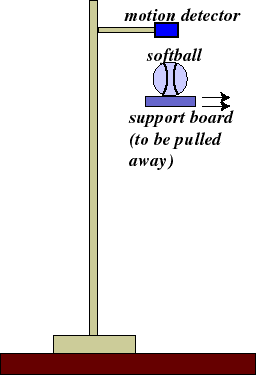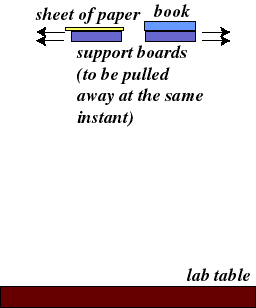Recap on Motion

Definition: average acceleration is the change in velocity over the time elapsed.

Using the motion detector and graphing software, try moving to match an acceleration vs. time graph. Is it simpler to match a velocity-time graph, like above?
Note that we should usually be very careful when describing the motion of an object. The expression above relates acceleration in one dimension (x) to the velocity (speed, really) in that direction and time. To fully describe the motion of real-world objects, we need to keep track of motion (positions, velocities and acceleration) in all three dimensions. If we aren't careful about this, it will come back (soon!) to haunt us.
So we really have just succeeded in carefully defining some (physics) variables that help describe our system (an object in motion). Big deal! Things become more interesting when forces are applied to them.
The fan attachment exerts an almost constant force on the cart. What is the relationship between that strength of that force and the cart's acceleration?We know about position, velocity and acceleration. Obviously, (strength of) force is another consideration. Are there any other important variables?
Time for an Interactive Lecture Demonstration (ILD):Hypothesis I: acceleration is proportional to total force (for constant mass).

Experiment I: test hypothesis I. How do we do this?
What about when we vary mass?
Hypothesis II: acceleration is inversely proportion to mass (when force is held constant).

Experiment II: test hypothesis II. How do we do this?
Result: Hypotheses I and II are correct. They can be summarized as Newton's Second Law:

An important postulate to this is Newton's First Law:
If the sum of the forces on an object is zero, it is not accelerating. Hence, if an object is in motion and the sum of forces on it are zero, it will stay in motion (maintain a constant velocity).
| Let's observe the effect of "gravity" on a softball with the following experimental setup: |  |
Question: What happens when the board is pulled out from under the softball?Answer: Duh, let me guess.....
Question: So, HOW is the ball moving towards the ground?
Answer: The ball is accelerating towards the ground, as we observe its velocity to be changing at a constant rate over time.
Question: If the ball is accelerating, what is causing the acceleration?
Answer: The "force of gravity," the attraction between the Earth and the softball, is causing the ball to accelerate downwards.
Question: Is the "force of gravity" the same for lighter or heavier (less or more massive) objects of a similar shape?
| Try this experiment: |  |
Answer: OK, so they both hit at the same time (after suitable modification). That means that they both accelerated in an identical manner, speeding up towards the table at the same rate. By Newton's II Law, the force of gravity acting on them is NOT the same. It varies in just the right way, according to their mass, so that they have the same acceleration.
Let's take a look at the forces exerted on a motor vehicle by its environment. Those forces are:If the vehicle is maintaining a constant velocity, then by Newton's first law the sum of the forces on it is zero. Then the motive force, exerted by the engine on the car, is equal in magnitude to all those other forces combined.
Limits on the first two forces on the right are determined by engine size. They represent the extra force necessary to either accelerate the car from standing still, or to push it up a hill.
During normal operation (relatively low speeds), the rolling force is the largest of the four. As a car goes down the road, its tires are constantly deforming as they roll. Overcoming this rolling resistance requires effort from the car's engine.
The last term is the force of air on a moving car. The car must displace air out of its way as it travels. For a given car, this term depends both on the cars drag coefficient (how far the air must move to get out of the way) and the car's speed. The "aerodrag" force increases linearly with the coefficient of drag. It increases with the velocity of the car squared. The latter means the engine of a car moving at twice the speed must exert four times the force.
![]()
Previous Lecture
Next Lecture
Back to Course Page.